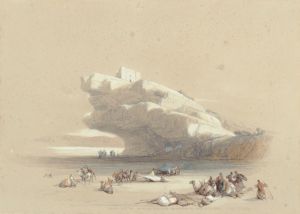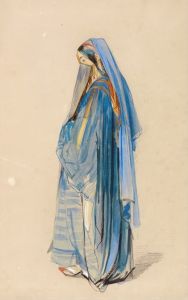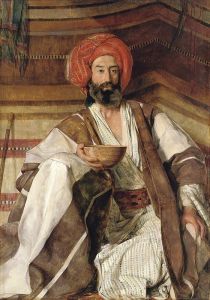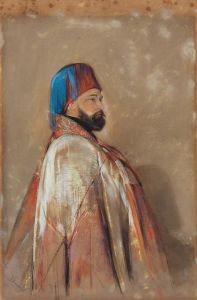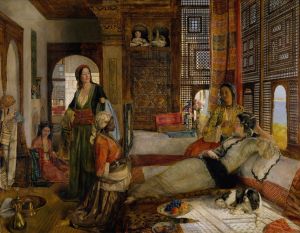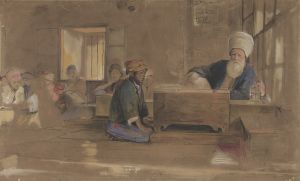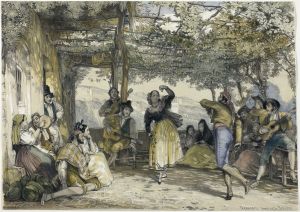
The Hypaethral Temple At Philae, Upper Egypt
A hand-painted replica of John Frederick Lewis’s masterpiece The Hypaethral Temple At Philae, Upper Egypt, meticulously crafted by professional artists to capture the true essence of the original. Each piece is created with museum-quality canvas and rare mineral pigments, carefully painted by experienced artists with delicate brushstrokes and rich, layered colors to perfectly recreate the texture of the original artwork. Unlike machine-printed reproductions, this hand-painted version brings the painting to life, infused with the artist’s emotions and skill in every stroke. Whether for personal collection or home decoration, it instantly elevates the artistic atmosphere of any space.
"The Hypaethral Temple At Philae, Upper Egypt" is a painting by the British artist John Frederick Lewis, created in 1864. John Frederick Lewis (1804-1876) was a prominent Orientalist painter known for his detailed and vibrant depictions of Middle Eastern and North African scenes. His works often reflect his extensive travels and deep interest in the cultures and landscapes of these regions.
The painting depicts the hypaethral (open to the sky) temple at Philae, an island in the Nile River in Upper Egypt. Philae was a significant religious site in ancient Egypt, dedicated primarily to the goddess Isis. The temple complex at Philae was renowned for its architectural beauty and historical significance, with structures dating back to the Ptolemaic and Roman periods.
In "The Hypaethral Temple At Philae, Upper Egypt," Lewis captures the grandeur and serenity of the temple ruins. The painting showcases the temple's columns and intricate carvings, bathed in the warm light of the Egyptian sun. The open sky above the hypaethral section of the temple emphasizes the unique architectural feature that distinguishes it from other temples, which were typically roofed.
Lewis's attention to detail and use of light and shadow create a realistic and immersive scene, transporting viewers to the ancient site. His work is characterized by a meticulous approach to capturing the textures and colors of the stone, as well as the play of light on the temple's surfaces. This level of detail reflects Lewis's background as a draftsman and his commitment to accurately representing the places he visited.
The painting is part of a broader trend in 19th-century European art, where artists were fascinated by the exotic and ancient cultures of the Middle East and North Africa. This movement, known as Orientalism, often romanticized and idealized these regions, though Lewis's work is noted for its respectful and accurate portrayal of the subjects.
"The Hypaethral Temple At Philae, Upper Egypt" is held in the collection of the Victoria and Albert Museum in London. The museum acquired the painting in 1865, shortly after it was completed. It remains an important example of Lewis's work and a significant piece within the Orientalist genre.
John Frederick Lewis's contributions to art extend beyond his paintings; he also influenced other artists and the public's perception of the Middle East and North Africa. His works continue to be studied and appreciated for their artistic merit and historical value, offering insights into the 19th-century European perspective on these regions.
In summary, "The Hypaethral Temple At Philae, Upper Egypt" by John Frederick Lewis is a masterful depiction of an ancient Egyptian temple, reflecting the artist's skill and the broader 19th-century fascination with Orientalist subjects. The painting remains a valuable piece of art history, housed in one of the world's leading museums.





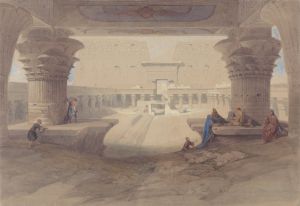
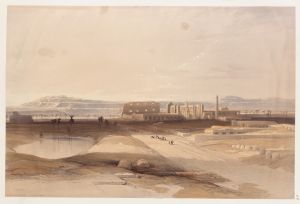

![Portico of the Temple of Edfou [Idfû], Upper Egypt. Nov. 23rd, 1838.](/imgs/217527/s/david-roberts-portico-of-the-temple-of-edfou-idfu-upper-egypt-nov-23rd-1838-79b6cf5b.jpg)

![Temple of Kalabshee [Kalabsha, Kalâbishah], Nubia. Nov. 1838.](/imgs/217548/s/david-roberts-temple-of-kalabshee-kalabsha-kalabishah-nubia-nov-1838-be0ac440.jpg)
